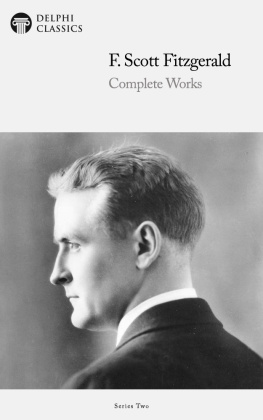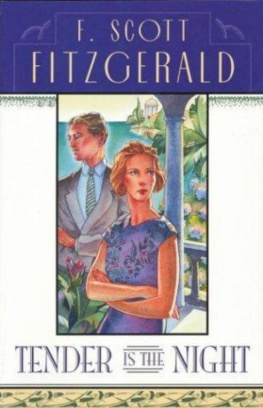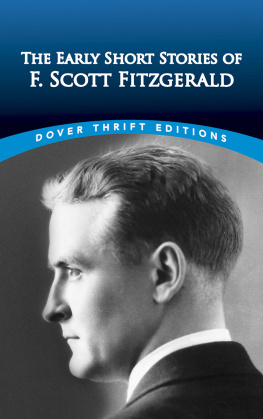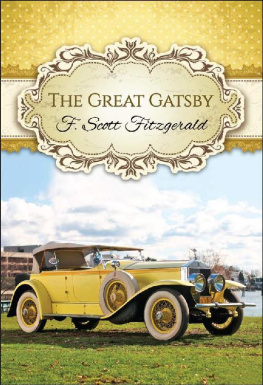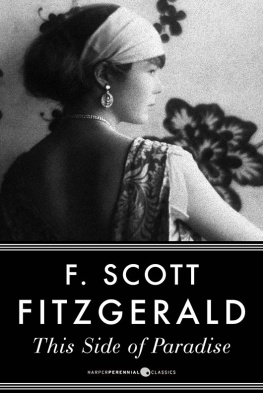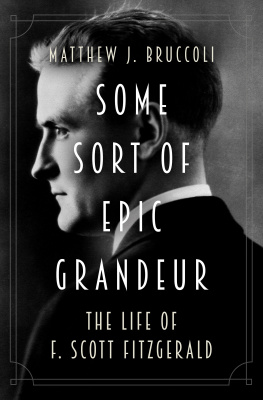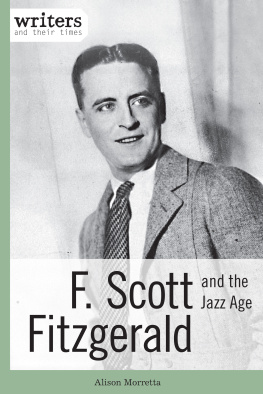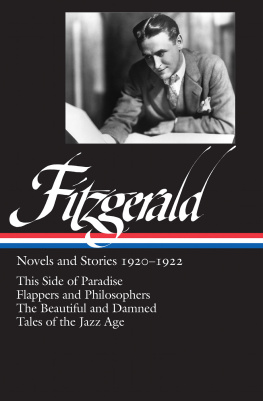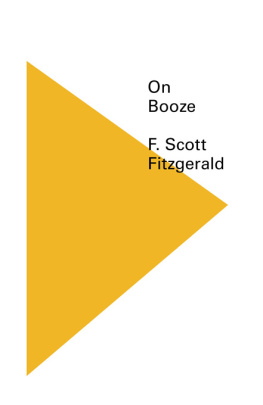
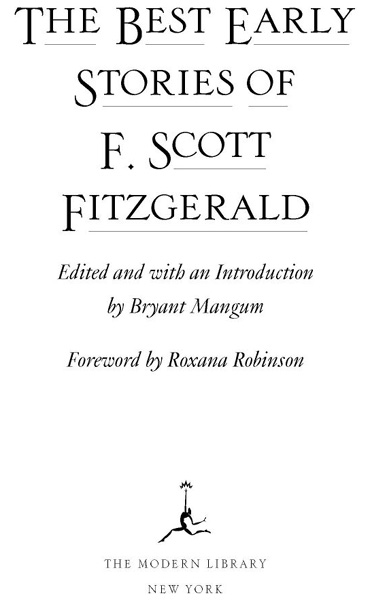
Table of Contents
A NOTE ON THE TEXT
Nine of the stories in this volume have been reprinted from original first printings of the volumes in which they were first collected: Flappers and Philosophers (New York: Charles Scribners Sons, 1920), Tales of the Jazz Age (New York: Charles Scribners Sons, 1922), and All the Sad Young Men (New York: Charles Scribners Sons, 1926). Only minor typographical corrections have been made, three of them silent punctuation changes. In May Day one proper name has been changed and one word has been deleted. Both of these are noted within the text. For the sake of consistency the Roman numeral I has been removed from the beginning of The Diamond as Big as the Ritz. The text of Winter Dreams was reprinted from Metropolitan Magazine, December 1922. The stories are arranged chronologically by date of composition.

FOREWORD
Roxana Robinson
What is more beautiful than the landscape of loss? What is more heart-breaking, more haunting, more romantic?
F. Scott Fitzgerald saw the world as a place of unbearable beauty and unlimited glamour. He saw it as illuminated by the glory of the natural landscape, by the glitter of the people, and by the perilous, irresistible pull of love. He was a romantic, and the greatest of his writing is charged with feeling and haunted by a longing for something irretrievable.
In these stories, written between 1919 and 1923, when he was in his early twenties, we see him setting out on the mountain of his experience, choosing the veins of ore he would begin to mine. We knowas he does notwhich ones will peter out and vanish, and which will deepen to become the mother lodes of his work. He writes, of course, about his generation, and about their experience, and of his own. He writes of their rebellion; he writes about a beautiful and impetuous young woman who seems the soul of this rebellion. He writes about wealth; he writes about religion; he writes about class; he writes about the great divide between the North and South. Some of these themes will be part of the great work that lies ahead, and some are part of the great work in this collection. All of them are set against that wide, murmuring landscape of loss.
The rebellion of Fitzgeralds generation is shown through various means, and religion and the young woman both play a part in it. The young woman appears in almost all of these stories, and is, in her earliest incarnation, The Flapper. Frivolous, saucy, and impetuous, she was an innovation, and utterly unlike her literary contemporaries. Ellen Olenska from The Age of Innocence, published in 1920, was also beautiful and high-spirited, but she was deeply respectful of societys rules, and suffered when these rules were broken. The Flapper flouted rules with impunity. She scorned chaperones, curfews, long skirts, maidenly virtue, and seemly behavior. Suddenly it was hard to tell a nice girl from the other kind.
Fast cars, rowdy drinking, wild dancing, and the bobbing of hair were all part of the roil of social revolution. Its hard now to imagine how shocking bobbed hair was, but at that time, a womans hair was never cut. A young girl wore her hair down in braids until she was old enough to put it up. The heavy, majestic burden, pinned discreetly aloft, was a declaration of womanhood, holding the promise of hidden sexuality. A womans hair was her crowning glory, and a source of pride. (When my great-grandmother had scarlet fever, the doctor ordered her to cut off her ankle-length locks. She refused, instead coiling her hair on the floor beneath her bed. Death, apparently, was preferable to shearing, though she survived.)
The wild women of the 1920s cared for none of this. They wore their hair short and swingy, with thick bangs and saucy spit curls, and they ignored the shock waves rippling through the ranks of stolid matrons. Bernice Bobs Her Hair is about many thingswomens friendship, and social conventions, and ways in which a young woman might present herself to the worldbut its also about the social risk and private daring entailed in bobbing.
Some of the Flappers are northern and some southern: the differences between the cultures were significant to Fitzgerald, whose father was from an old Maryland family. Fitzgerald was stationed in Alabama during the War, where he fell in love with the famously wild Zelda Sayre, of Montgomery. Zeldas incandescent personality illuminates many of Fitzgeralds women, though another important model for them was Ginevra King, a northerner, who was the object of an earlier, unrequited love. The North and South were potent presences in his work, and at times they nearly dominated the narrative.
Beautiful and hallucinatory, The Ice Palace tells of the southern girl Sally Carrol, who comes from a languid paradise of dreamy skies and firefly evenings... [one of the] soft-voiced girls, who were brought up on memories instead of money. When she visits Harry, her fianc, in Minnesota, Sally Carrol encounters a new worlda bleak frozen landscape dotted with isolated farmhouses and blanketed in snow.
Describing the South, Fitzgeralds tone is ironic and patronizing; he both articulates and disparages its easy charms. But when he turns to the North his tone becomes earnest, acquiring richness and authority: this may be the first emergence of Fitzgeralds mature voice. Powerful, dark, and intense, it is superb writing.
There was no skyonly a dark, ominous tent that draped in the tops of the streets and was in reality a vast approaching army of snowflakeswhile over it all, chilling away the comfort from the brown-and-green glow of lighted windows and muffling the steady trot of the horse pulling their sleigh, interminably washed the north wind.... She thought again of those isolated country houses that her train had passed, and of the life there the long winter throughthe ceaseless glare through the windows, the crust forming on the soft drifts of snow, finally the slow, cheerless melting, and the harsh spring...
Visiting the Ice Palace, Sally Carrol becomes separated from Harry, and wanders alone through the black and chilling halls. In the deep silence she stumbles finally to a halt, overtaken by ecstatic terror. This is her introduction to the true nature of the North, which, she now understands, is beyond herendless, ancient, and implacable. After her rescue, Sally Carrol flees to the easy life of the South, where the moment of fear and transcendence will never be repeated, and where such demands are not made upon the soul. The South is a pleasant place, but the North, Fitzgerald tells us, is one of dark magnificence. It is this sense of brooding nobilityas well as Fitzgeralds passionate, incantatory voicethat overshadows the human characters and dominates this story.
For all her unconventional ways, Zelda refused Fitzgerald, at first, on very conventional grounds: financial ones. The beautiful young women in Fitzgeralds work are often wealthy, or aspirants to wealth. Money held a deep and ambivalent fascination for the author, who had grown up poorer than his neighbors. In St. Paul, his family lived modestly among the very rich, and Fitzgerald went to school and college with their sons. He had seen the rich from very close, but always from below. Money played a powerful part in his world and in his writing, and its influence was something he explored, in ways increasingly subtle and complex.
Next page

